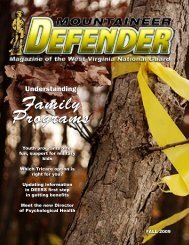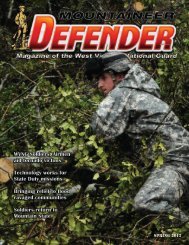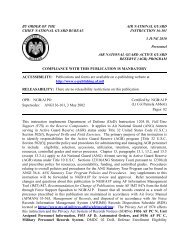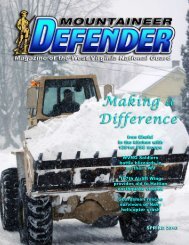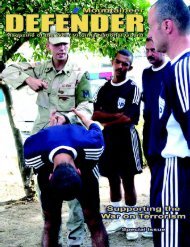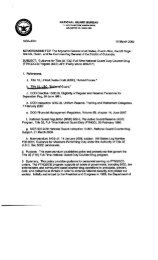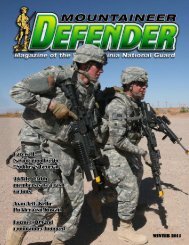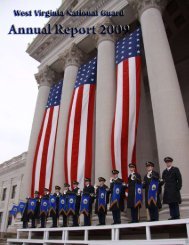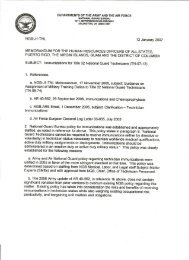2012 Q2 - West Virginia Army National Guard - U.S. Army
2012 Q2 - West Virginia Army National Guard - U.S. Army
2012 Q2 - West Virginia Army National Guard - U.S. Army
- No tags were found...
You also want an ePaper? Increase the reach of your titles
YUMPU automatically turns print PDFs into web optimized ePapers that Google loves.
WELCOME HOME!130th Airlift Wingmembers return fromAfghanistan<strong>Guard</strong> memberstake part in “activeshooter” exerciseLeadership Campteaches teamwork,disciplineSummer <strong>2012</strong>
The Adjutant GeneralCommand Messages 3Educate yourself! 4130th Airlift Wing members 5return from deploymentExercise, exercise, exercise! 6Active shooter targets <strong>Guard</strong>C-5 conversion draws 7to a closeAround the <strong>West</strong> <strong>Virginia</strong> 8<strong>National</strong> <strong>Guard</strong>YLC takes dedication, 10teamwork, disciplineSpecial Olympics brings smiles 11to athletes, <strong>Guard</strong> volunteers167th Airlift Wing 12preps for deploymentHook up! 13Slingload ops at Camp DawsonGood samaritan feeds 14Soldiers, first respondersRecruit Sustainment Program 15readies new troopsMagazine of the<strong>West</strong> <strong>Virginia</strong> <strong>National</strong> <strong>Guard</strong>Summer <strong>2012</strong>Page5Page7Page6Page10Adjutant GeneralMaj. Gen. James A. HoyerState Senior Enlisted LeaderCommand Sgt. Maj.Lawrence R. VanceState CommandChief Master SergeantCommand Chief Master Sgt.Ronald D. BoweState Public Affairs Officer &Editor-in-ChiefLt. Col. David LesterDesign & LayoutSgt. Anna-Marie WardThe Mountaineer Defender is anauthorized publication of the <strong>West</strong><strong>Virginia</strong> <strong>National</strong> <strong>Guard</strong>. Contentsare not necessarily the officialviews of, nor are they endorsedby, the United States government,the Department of Defense, the<strong>West</strong> <strong>Virginia</strong> <strong>National</strong> <strong>Guard</strong> orthe state of <strong>West</strong> <strong>Virginia</strong>. Publicationof material is determined by availablespace and reader interest.The staff reserves the right to editall material.The State Senior Enlisted LeaderThe State Command Chief Master SergeantAs many of you know I am a huge fan ofhistory. I feel that by looking at the past we canmake sure we repeat successes and not failures.We all go to work every day to ensure we areproviding for our family and for hopes that theyhave a better life because of it. Recently, I hadthe privilege of talking to several of our retireesacross both the <strong>West</strong> <strong>Virginia</strong> <strong>Army</strong> and Air<strong>National</strong> <strong>Guard</strong>. These men and women are theones I thank for all of the opportunities they havegiven me and the WV <strong>National</strong> <strong>Guard</strong>.Whether it was chewing me out when Imessed up, mentoring me on how to be a leader,or making sure I didn’t kill myself jumping outof an aircraft, these folks were there for me andinvesting in my future.That is the power that lies behind Joint Base<strong>West</strong> <strong>Virginia</strong>. Creating opportunities for menand women to raise their families in <strong>West</strong> <strong>Virginia</strong>and serve the <strong>National</strong> mission. By in-Maj. Gen. James A. Hoyervesting in these endeavors, we are providingmembers of the WVNG full-time employmentopportunities to build their families’ future andLooking for that next challenge after completingyour SSD and NCOES requirementsfor promotion consideration? You’re probablylooking for that certain thing that will give amotivated Soldier an extra edge during the nextpromotion board.Have you thought about competing in theWVARNG Best Warrior Competition? Competingin the BWC can open opportunities toattend specialty schools that will give you anedge. When a promotion board member reviewsyour records and sees you’ve won the Soldier orNCO of the Year completion, this indicates a topblock Soldier. Promotion board members are alwayslooking for those special qualifications andachievements that make a successful leader.Have you considered competing for the GermanArmed Forces badge for military proficiencyat Camp Dawson? Obtaining the GermanArmed Forces badge is another way of provingyou are top block.Have you ever heard of Sergeant Audie Murphy?Who is Sgt. Audie Murphy? What is theSgt. Audie Murphy Club?Sgt. Audie Murphy is America’s Most DecoratedWorld War II Combat Soldier. As a squadleader, he consistently demonstrated the highestqualities of leadership, professionalism, and regardfor the welfare of his Soldiers.The Sgt. Audie Murphy Club is an elite organizationof NCOs whose demonstrated qualitiesand abilities are characterized by those ofSgt. Audie Murphy. Membership in the ARNGSAMC is a reward for NCOs whose leadershipthe future of the WVNG.One example of a veteran that continuesto give back to America is Hershel “Woody”Williams. I will end with a quote he gave to theWV Veteran’s Legacy Project talking about themen and women from W.Va. who serve in themilitary.“I want to say <strong>West</strong> <strong>Virginia</strong> has been myhome. I’ve worked in other states. But I’m alwaysdrawn back to <strong>West</strong> <strong>Virginia</strong>. I think we’reunique people in many, many ways. One of themost outstanding ways is, per capita, we havehad more people serve our armed forces thanany other state. We have had more prisoners ofwar. We have had more people killed, per capita,than any other state. So, there is a patriotism inthe state of <strong>West</strong> <strong>Virginia</strong> that I don’t think youfind in other places. And if America ever got intotrouble, <strong>West</strong> <strong>Virginia</strong>ns would be there. I haveno doubt of that.Command Sgt. Maj. Vanceand performance merit special recognition.These opportunities may be what you arelooking for to give you that extra challenge andboost toward promotion!We’re online!Access this and previous issuesof Defender Magazine! Use youriPhone, tablet or Android app to scanthe QR Code to the right.On the cover:Members of the 130th Airlift Wing returned froma 120-day deployment to Afghanistan July 13,<strong>2012</strong>. Airmen were greeted with shouts, screamsand tears of joy by family members and friends atYeager Airport in Charleston, W.Va.Photo by Staff Sgt. Billy Hinamon, 130th AW Public AffairsSend comments/contributions to:State Public Affairs OfficeWV <strong>National</strong> <strong>Guard</strong>1703 Coonskin DriveCharleston, WV 25311orMountaineerDefender@ng.army.milvisit us on Facebookwww.facebook.com/WV.<strong>National</strong><strong>Guard</strong>Command Chief Master Sgt. BoweAs I write to you today it will be my lastarticle as your State Command Chief MasterSergeant. It has been my honor and privilegeto serve as your State CCM for the past sevenyears. I want to thank each of you for volunteeringto serve our Nation, for fighting the GlobalWar on Terror and for keeping our Air <strong>National</strong><strong>Guard</strong> and the state of <strong>West</strong> <strong>Virginia</strong> strong.We’ve overcome many challenges such asBRAC for the 130th and the C-5 conversion forthe 167th. Great milestones, but times have becometougher with budget cuts and new airframetransformations at the 167th Airlift Wing. This isthe sign of the times, it’s not going to get easierto stay viable in the future.With this being said, I believe you are the bestAirmen in the world. I whole-heartedly believedthis then; and now, after 7 years of travelingaround the Nation and seeing our Air Force, andmeeting with so many of you and witnessing thetremendous feats you accomplish every day, Iam convinced even more.Your pride and professionalism are awesomeand continue to make the difference in our abilityto accomplish our mission. We dominate in air,space, and across the planet because of you. Youtruly are our Nation’s greatest asset.In the Global War on Terror you’ve takenthe fight to the enemy and defeated them everywhereyou engaged. As the war continues, youmust remain resolute, strong, and prepared tofight anytime and anywhere that our liberties, orthose of our allies, are threatened. I am confidentthat just as those who came before us overcamechallenges, you will continue to soar ahead withcourage, commitment, and conviction.I have had opportunities that very few havethe luxury of receiving and have truly beenblessed. The professionalism and dedicationdemonstrated by all of you is incredible. As I reflectback over my 41 years and 9 months, therehave been great times and hard times and I cantruly say the great outweighs the bad and if I hadto do over again I wouldn’t change a thing.Now for the last time, as always, I salute youand your families for your sacrifices, May Godbless you all.2 Summer <strong>2012</strong>3
State Colleges, Universities offer educationopportunities for <strong>National</strong> <strong>Guard</strong> membersby 2nd Lt. Madalyn M. OltmanEducation Services OfficerThe <strong>West</strong> <strong>Virginia</strong> <strong>National</strong> <strong>Guard</strong>Education Office has been working withnumerous institutions to help provideour Soldiers and Airmen with the besteducational opportunities available. Thereare a variety of programs that Universitiesoffer that cater to the non traditional styleof our <strong>National</strong> <strong>Guard</strong> members. Currently,Concord University, <strong>West</strong> <strong>Virginia</strong>University, University of Charlestonand Wheeling Jesuit University haveprograms that accommodate our chaoticlifestyles.Concord University’s RegentsBachelors of Arts program is especiallywell suited for active duty <strong>Guard</strong>smen.With the RBA program students areallowed to add an Area of Emphasisto document their expertise which willprovide seamless transition from the RBAto an online Masters program of theirchoice.<strong>West</strong> <strong>Virginia</strong> University offersan Executive Masters of BusinessAdministration Cohort for <strong>National</strong><strong>Guard</strong>smen. This program is targetedspecifically towards workingprofessionals and provides flexibleschedules through the combination ofonline course work augmented by someclassroom interaction.The University of Charleston is alsooffering an Executive Masters of BusinessProgram offers healing forwounded warriorsThe mission of Project Healing WatersFly Fishing is to assist in the physical andemotional rehabilitation of disabled activeduty military personnel and veteransthrough fly fishing and fly tying educationand outings.For more information, please visit www.projecthealingwaters.org or Maj MichaelBeckner at 304-561-6333. You can alsoemail virginias@projecthealingwaters.org for regional information.Administration program geared towards<strong>National</strong> <strong>Guard</strong>smen. The Universityoffers a grant to WVNG members to helpalleviate some of the cost.Wheeling Jesuit University hasprograms that challenge students tolead effectively and affect positivechange in organizations. The Bachelorof Arts in Organizational Leadershipand Development andMaster ofNews You Can UseWebsite offers tutor servicesfor military familiesSchool is in! The Defense Departmentoffers military families access to free,online tutoring at Tutor.com. The site offersprofessional tutors who can assist withhomework, studying and test preparation.Services are available to students of anyage -- from kindergartners to high schoolseniors -- with help offered in more than 16subjects.For more information, please visit http://www.tutor.com/military.Science in Organizational Leadership offer<strong>Guard</strong>smen the opportunity to developintellectual and personal skills needed tofunction as managers and executives in thework force.For additional information on theseprograms, please contact Sgt. BrandonHodge in the <strong>West</strong> <strong>Virginia</strong> <strong>National</strong> <strong>Guard</strong>Education Office at Brandon.hodge@us.army.mil or (304) 561-6359.Like to travel? Space A can getyou there.Space Available Flight, better known asSpace A or military hops, is a unique privilegeprovided to servicemembers, retireesand their families.Under the Space-Available program,eligible passengers can fill unused seats onDoD-owned or controlled aircraft once allthe space-required passengers and cargohave been accommodated.Visit http://www.military.com/Travelfor more information.130th Airlift Wing members return from Afghanistanby Staff Sgt. Shane Arrington130th Airlift Wing Public AffairsCHARLESTON, W.Va. (July 13, <strong>2012</strong>) -- C-130s landing atYeager Airport in Charleston, W.Va. usually happen without fanfare,but on Saturday, July 13, there were tears and screams as onecarrying Airmen returning from their deployment touched down toreunite them with their loved ones.The contingent of 130th Operations, Maintenance and Supportpersonnel flew and maintained C-130 aircraft while completing280 missions in support of Operation Enduring Freedom inAfghanistan and Kuwait.“For the last 120 days these men and women have been engagedin the Global War on Terrorism,” said Col. Jerry Gouhin, 130thAirlift Wing commander. They were in Afghanistan originally andthen in mid-rotation they moved to another location. They had amission capable rate of more than 90 percent, which is outstandingby any standards whether peacetime or wartime. They flew morethan 2,800 hours, which is something we would typically fly in ayear here, they flew in 120 days.”Gouhin also mentioned that the deployed Airmen not only putup impressive numbers, but also did it with a mishap free safetyrecord. He said he’s proud of everyone who deployed and theiramazing accomplishments -- especially considering toward theend their families were fighting a war of their own back home.“Their families have been through a major storm here in <strong>West</strong><strong>Virginia</strong> with power outages and they’ve also had to deal withthat,” Gouhin said. “Everyone has done a super job. The commitmentof these men and women is phenomenal. Like I’ve said, Icouldn’t be more proud of what they’ve accomplished and whatthey give to the state and Nation every day.”The <strong>National</strong> <strong>Guard</strong> used to be referred to as “weekend warriors,”but for many members, such as Tech. Sgt. Jeremy Fallecker,Flight Engineer with the 130th Airlift Wing, this wasn’ttheir first deployment. It’s never easy leaving family and friendsbehind, but Fallecker said technological advancements and familiaritywith simply being deployed help make things go a littlemore smoothly.“This is my third deployment and everyone gets a little easierwith the communications back home,” Fallecker said. “Internet isbetter every time we go back, news feeds are better every time wego back, the infrastructure there for us personally is getting muchbetter -- it all makes it a lot easier to keep in touch with the folksat home and stay abreast of current events. We were all aware ofthe storm pretty much within a couple of hours of it happening.”Fallecker said fortunately his family had somewhere to go withpower, but it wasn’t easy on those who lost communications withtheir families. He said no one liked it, but they had a job to do andyou just have to “keep on keeping on.”While it was difficult to be gone, and toward the end withoutcommunication for some, it is also not easy being the ones leftbehind. Fallecker’s wife, Jennifer, said while she’s proud of thejob her husband does while deployed she’s beyond happy to havehim back.“We’re just going to relax and spend time with each other,” Jennifersaid. “You never really get used to it, but this one has beenhard on the kids. My husband missed our son’s first birthday asTech. Sgt. Jeremy Fallecker, Flight Engineer with the 130th Airlift Wing, <strong>West</strong> <strong>Virginia</strong>Air <strong>National</strong> <strong>Guard</strong>, poses with his daughter after returning to Charleston, <strong>West</strong> <strong>Virginia</strong>from a 120-day deployment to Afghanistan in support of Operation Enduring Freedom.(U.S. Air Force Photo by Tech. Sgt. Bryan G. Stevens)well as his daughter’s eighth. He’s been deployed before, but thisis the first one she remembers. There were no behavior problemsor anything like that, just sadness.”Fallecker’s daughter Jaiden said she missed her dad a lot, buttalking on the phone with Skype made it easier. She also said shelooks forward to going on vacations and fishing with her dad -something Fallecker also looks forward to.“On leave I’m going to get back into my leisure time, my fishing,”Fallecker said. “Were going to take a little vacation, spendsome quality time with each other and just have some fun thissummer before the kids go back to school.”All in all Fallecker said he just can’t wait to get back into hisroutine. He said the toughest part about returning is not steppingon the toes of what the spouses have set up while their husbandsor wives are deployed.“The jobs the spouses have at home are incredibly difficult, andI think people fail to realize that sometimes,” Fallecker said. “Andeven when you come home getting back into the regiment yourspouse is used to doing by his or herself is difficult. The transitiontakes time. You can’t just jump in feet first.”4Summer <strong>2012</strong>5
Active shooter exercise tests Airmen mettleby Airman 1st Class Nathanial Taylor167th Airlift Wing Public AffairsMARTINSBURG, W.Va. (August 1,<strong>2012</strong>) -- Members of the 167th AirliftWing participated in an on-base, activeshooter drill early Wednesday morning.The drill was designed to simulate anactive shooter scenario and evaluate thebase-wide response.“We have these drills so that if asituation does occur, our personnel aretrained on how to respond to the incident,”said Capt. Timothy Rice, the baseantiterrorism and intelligence officer.Adding: “These types of scenarios arehappening throughout the world and thesedrills help to better educate our people.”The drill which incorporates variouselements and tactics that terrorist haveused before, is one of five exercises thatthe Department of Defense requires fromits agencies annually, said Senior MasterSgt. David Stevens, the base emergencymanager.“The DOD really emphasizes theimportance of active shooter drills,”Stevens said. “There has been a lot offocus on the active shooter because of theFort Hood shooting.”“Everything in the scenario is realistic,there is nothing that is totally off thewall,” Stevens said. “We want to makethem realistic and we want to make themrelevant.”Wednesday’s drill was no exception tothat rule.It began with a simulated car bombthat was positioned outside building 134.Several loud explosions coupled withsmoke that was released from a suspiciousvehicle acted as the bomb. Casualtiesplayed by base personnel littered the sidewalk and grass of the immediate area.The drill became an active shooterscenario when a gunman, played byRice, opened fire as emergency vehiclesarrived on scene. The shooter then madehis way to building 120, leaving severalmore casualties in the surrounding area.When Security Forces personnel arrived atbuilding 120 they found the shooter insideand were able to successfully detain him.After the building was secure, the baseFire Department worked in conjunctionwith local emergency responders to treatand transport casualties.According to Rice, This year’s drill wasSenior Master Sgt. John Cordova and Tech. Sgt. Max Kline handcuff Capt. Timothy Rice, playing the part of an activeshooter, during an exercise at the 167th Airlfit Wing on Aug 1, <strong>2012</strong>. (U.S. Air Force photo by Tech. Sgt. MichaelDickson, 167th Airlift Wing Public Affairs)different than previous drills.“What is different this year is that whilewe are doing our drill here, three otherlocations around the state will also beparticipating in drills,” he said.Small exercises that consisted ofintelligence updates to base personnel wereheld throughout the week leading up tothe drill, Rice said. This intelligence wasmeant to build up to the drill day and makethe scenario seem more real.The scenario forced individuals who areusually in secondary roles to step up andbecome main players, Stevens said. It wasdesigned to test every aspect of what couldhappen in a real situation.Both Rice and Stevens emphasized theimportance of training and being preparedfor any situation.“It goes back to training,” Rice said.“The more you do it the better off you aregoing to be. If you only practice somethingonce or twice every three years, you aregoing to end up behind the eight ball.”“These drills are absolutely beneficial tothe Wing’s effectiveness,” said Rice. “Youhave to train to find out what is missingand what isn’t there in your plans. If youdon’t practice, you will never know.”“Executing these types of scenariosallows us to test our plans,” said Stevens.“We are training and utilizing all ourresources making sure we can do what weneed to do when it is time to come to thefight.”Rice stressed how important it is towork side-by-side with the local resourcesavailable in Berkeley County.“The more you train with an agencythat you don’t normally work with, thebetter you will understand each other’scapabilities,” he said.“We rely heavily on our civilianresponders,” Stevens said. “Being a guardunit, we don’t have everything that theactive duty has within our internal respondmechanisms. With something of thismagnitude we definitely need that asset(civilian responders) here on station tosource our people to various hospitals.”Stevens went on to say that “Beingable to reach outside the fence and pull inresources is enabling us to do a lot morethan we could do with just us running aninternal exercise.”To Rice, the main reason for havingthese types of drills is to educate and makepersonnel more comfortable in a widerange of situations.“My biggest thing is that everyoneis more familiar with an active shooterscenario or with any incident that occurs onbase,” Rice said. “This is a real event thatcould occur anywhere and it is somethingthat we can’t mess up.”(Editor’s note: The 130th Airlift Wingand <strong>Army</strong> <strong>National</strong> <strong>Guard</strong> Headquartersin Charleston, W.Va. along with CampDawson in Kingwood also participated inthe Aug. 1 active shooter exercise.)C-5 conversion draws to close with taxiway extensionby Sgt. Sherree Grebenstein167th Airlift Wing Public AffairsMARTINSBURG, W.Va. (August 8,<strong>2012</strong>) -- Blame Mother Nature.If it hadn’t been for her, the final phaseof the 167th Airlift Wing’s C-5 conversionprocess would have been completedby now. Instead the steady rains whichsaturated Martinsburg in April and Mayof last year delayed completion of the C-5taxiway extension.Completion of the final phase of thebase’s conversion process is expected towrap up by the end of this month.“This is the last military constructionproject for the base’s C-5 bed down,” saidMaj. Paul Henry, the Wing’s deputy basecivil engineer. The Wing is currently hometo 11 C-5 aircraft.The contract for the final phase of theairfield’s conversion was awarded in 2010to Atlantic Contracting & Material Co.,Inc., based in Upper Marlboro, Md.“We really didn’t start actual active constructionuntil April of 2011,” Henry said.Adding: “We didn’t move mountains,but we moved a lot of earth.”The price tag of the last upgrade to theairfield was just shy of $10 million with theoverall four-phase, half-decade plus undertakingcosting approximately $50 million.Under the final phase, the taxiway wasrealigned and widened by 15 feet.“It’s now 75 feet of taxiway with 25foot paved shoulders on each side,” Henrynoted.New LED lights were installed on theexisting portion of the taxiway to the westallowing for the entire taxiway to be illuminated,with the new energy saving lights.Originally the project was slated for hotmix asphalt to be used for pavement, butconcrete was used instead. Henry said theupgrade to concrete did not run the projectover budget and is more practical.“It’s a rigid pavement versus a flexiblepavement, the lifespan of (the concretepavement) is a lot longer,” Henry said. Henoted that as long as it’s maintained, theconcrete pavement can last for the next20 years. Approximately 15,000 to 20,000cubic yards of concrete was placed.The extended taxiway also allows forC-5 pilots to launch their aircraft withouthaving to make a U turn.“They can just go right off and launchContractors spray paint lines onto the edge of the newly aligned taxiway at the 167th Airlift Wing, Shepherd Field,Martinsburg WV, July 25, <strong>2012</strong>. Final touches are being made to the taxiway, which was recently realigned andextended; the final C-5 conversion construction project at the base. (Air <strong>National</strong> <strong>Guard</strong> photo by Master Sgt. EmilyBeightol-Deyerleoff the extended overrun take-off area,” hesaid. “It will save a lot of fuel and a lot ofwear and tear on the landing gear.”The base access road and taxiway Hotelwere extended to the realigned taxiwayAlpha and rehabilitated.“Bill Walkup (manager of the Eastern<strong>West</strong> <strong>Virginia</strong> Regional Airport) affectionatelynamed the access road Henry Waymany years ago during snow removaloperations,” said the Wing’s deputy basecivil engineer.Henry said completion of the final phaseof the conversion project will “definitelyimprove the quality of the airfield itself.”One man has had a hand in every stageof the multi-phase C-5 conversion processwith regards to the airfield itself.“Rick McLaughlin has been involved inevery airfield project that we have done,”Henry said. “He’s my right hand man. He’sout there day in and day out.”McLaughlin, a native of BerkeleySprings who now calls Martinsburg home,has close ties with the base. His brotherretired as a C-130 maintenance crew chieffrom the 167th Airlift Wing in 2002. Duringthat time McLaughlin got to knowLt. Col. Bill Burkhart who spearheadedthe base’s overall C-5 conversion processbefore retiring.As an inspector for Atkins Global basedin Nashville, Tenn., McLaughlin wastasked with ensuring work on the threerunway projects and taxiway extensionwere done to specification.He arrived on the job in May, 2006 withplenty of experience. He was an engineerat the Martinsburg Veterans AdministrationHospital from 1981 to 1986. For thenext 20 years he oversaw the revamping ofDulles International Airport in Chantilly,Va., before landing in his current role.He refers to himself as a “loaner to the<strong>Guard</strong>.”More than a “loaner,” McLaughlin is anexpert at understanding the intricate detailsof airfield’s overall upgrade.He noted that one detail of the upgradeseemed complex, but was actually quitelogical when put into context.“The primary runway length is the sameas it was when we started – 7,815 feet,”McLaughlin said. However, the 2008east extension project added another 1,000feet of pavement that can only be used fortakeoff to the west and landing to the east.He noted the total length hasn’t changed.It went through phases when the runwaylength had to be reduced because ofconstruction but the refurbishing did notreduce it.McLaughlin said each phase of upgradingthe airfield had its unique challenges.6 7Summer <strong>2012</strong>
summer<strong>2012</strong>Around the <strong>West</strong> <strong>Virginia</strong><strong>National</strong> <strong>Guard</strong>Soldiers and Airmen at their best(Above) Melanie Boyles, wife of Chief Master Sgt. David Boyles, douses her husband with champagne after achieving10,000 hours flighttime. (photo by Sgt. Anna-Marie Ward, JFHQ-WV Public Affairs Office)Clarrysa Kelley, 16, from Helvetia, W.Va., provides help as a junior counselor to Lexi Guthrie, 9, fromMorgantown, W.Va. on June 25. Children at Kid’s Kamp at Camp Dawson, W.Va. learned how toeffectively shoot bows and arrows at the archery range during camp. (U.S. <strong>Army</strong> photo by Sgt. SaraYoke, 153rd Public Affairs Detachment)Members of the 130th Airlift Wing returned to Charleston, <strong>West</strong><strong>Virginia</strong> after a 120-day deployment to Afghanistan in support ofOperation Enduring Freedom. (U.S. Air Force Photo by Staff Sgt. BillyHinamon, 130th Airlift Wing Public Affairs)Sgt. Aaron Anderson, <strong>West</strong> <strong>Virginia</strong> <strong>National</strong> <strong>Guard</strong>, helps load bottled water onto a UH-60 Blackhawk helicopter July 1. Thewater was bound for Greenbrier County, W.Va. to provide relief to local citizens left without power following strong storms thatdevastated the state June 29. (photo by Lt. Col. David Lester, JFHQ-WV Public Affairs Officer)Maj. Thomas W. Mills, 77th Brigade Troop Command, <strong>West</strong> <strong>Virginia</strong> <strong>Army</strong><strong>National</strong> <strong>Guard</strong>, discusses relief efforts with First Lady Joanne Tomblin inFayetteville, W.Va., at the 911 Center. (photo by Tech. Sgt. Bryan G. Stevens)Employers traveled to Fort Pickett in Blackstone, Va. to visit with members of the 150th Armored Reconnaissance Squadron as part of the Employer Support of the<strong>Guard</strong> And Reserve BOSS lift. Employers have the opportunity to see what their citizen-Soldier employees do during their time in uniform. Bosses also have thechance to participate in some “<strong>Army</strong> training.” (photo by Beth White, ESGR)
Discipline, team work keys to success at YLCby Staff Sgt. Debra Richardson153rd Public Affairs DetachmentKINGWOOD, W.Va. (June 24,2011) -- Stunned silence sweepsover a bus filled with teenagers fromacross the state as <strong>Army</strong> and Air<strong>National</strong> <strong>Guard</strong> Soldiers wearing yellowshirts scream orders for the newcampers to get off the bus.“Move, move, move!” they shoutas one by one, the campers line upsingle file along the bus, waiting forfurther instruction.As the campers shuffle into a smallbuilding to check-in, the yellowshirts make their way down the line.“Spit out that gum,” “straighten yourhat” and “stop eye-balling me” arejust a few corrections made as theline winds through the reception hall.The first day, reception, is the mostgut-wrenching day for those who optto spend a week at Camp Dawson inKingwood, W.Va., attending YouthLeaders Camp.“The first day sets the tone fordiscipline for the duration of theweek,” said Air Force Master Sgt.Victor Perry. “For many of thesekids, discipline has never beenenforced at their home or in theirschool.”Perry, a recruiting and retentionsupervisor with the 130th Air LiftWing, has volunteered at YouthLeaders Camp for the past 12 years.Throughout the week, camperslearn team-building by working asa team to rappel, climb a rock wall,compete in organized sports, conductwater survival, learn first aid andcomplete a timed obstacle course.Each platoon competes forstreamers which they attach totheir platoon’s guidon. Winning acompetition not only means braggingrights, but earns the platoon the rightto eat first for the entire day.“The competitive nature reallystarts to take over the campers byabout day three,” Perry said. “Thecampers start to act as a team andmake on-site corrections. They wantto win but it’s obvious that theywant each of their teammates tosucceed with whatever task they’reElyssa Montgomery, a junior-TAC (Teach, Advise, Counsel) instructor, directs the platoon leader of her group to rejoin theformation after giving him instructions on June 24 at Youth Leaders Camp at Camp Dawson, W.Va. (U.S. <strong>Army</strong> photos by Sgt.Sara Yoke)completing.”At graduation each year, a videohighlighting the week’s activities andthe campers’ progression is shownto all the kids, parents and staff inattendance. The parents are shockedto see their kids being reprimandedon the first day and are awe-struck tosee them leading and following as thevideo progresses.“After watching the video from thefirst day, parents wonder why thesekids come back,” Perry said. “Butthroughout the week, we build closerelationships with all of the kids andat the end of the week, they don’twant to leave.”Youth Leaders Camp is oftendescribed as a mini boot-camp,where most of the participants arecurrent members of their high schooljunior reserve officer training corps,or JROTC.“But that’s not the case,” Perrysaid. “These kids come fromeverywhere and JROTC is not aprerequisite. “This camp gives everycamper an opportunity to lead andbe led. The camp is designed forthem to fail if they try to make it asan individual; teamwork is the onlyavenue for success here.”A camper in Elyssa Montgomery’s platoon carefully makes his way tothe top of the rock wall on June 27 at Camp Dawson, W.Va. Montgomeryis a junior-TAC (Teach, Advise, Counsel) instructor at Youth LeadershipCamp. She returned to the camp as an instructor after being a camperfor three years.<strong>Guard</strong> members support community during Special Olympicsby Spc. Penni Harris153rd Public Affairs DetachmentCHARLESTON, W.Va. (June 2, <strong>2012</strong>)-- <strong>West</strong> <strong>Virginia</strong> <strong>National</strong> <strong>Guard</strong> membersparticipated in the Special OlympicsSummer Games this weekend at LaidleyField.“[<strong>Guard</strong>smen] help us with every singleaspect [of the Summer Games],” saidTabitha Lair, Olympic Village coordinator.Approximately 192 Airmen and Soldiersvolunteered to set up tents, assemble boccecourts, make and serve food to Olympiansand volunteers, and provide craft materialsand put crafts together with participants.“They [provide] about 75-80 percent of thevolunteers we have,” Lair said.Olympians ages eight through adulthoodparticipated in track and field, tennis,aquatics, cycling, softball, bocce and golf.<strong>Guard</strong>smen were stationed at the OlympicVillage tents to assist participants witharts and crafts, face painting, and karaokein between competition events. “They arewonderful with the children,” Lair said.“Essentially, the [<strong>National</strong> <strong>Guard</strong>] isa community-based organization. It isimportant for the <strong>Guard</strong> to give back tothe community because the communitysupports us in our war [and] state dutyefforts,” said Air Force Maj. Todd Miller,co-officer in charge of Special OlympicsSummer Games events for the <strong>West</strong><strong>Virginia</strong> <strong>National</strong> <strong>Guard</strong>.“Participating in community-basedevents, demonstrates to the communitythat we don’t just talk it, we walk it,” saidCommand Sgt. Maj. Lawrence Vance,state command sergeant major of the <strong>West</strong><strong>Virginia</strong> <strong>National</strong> <strong>Guard</strong>.“I think it gives guardsmen a sense offulfillment, [that] they can do somethingspecial ...” added Sgt. 1st Class Mary J.Ambler, JFHQ-WV, “that’s what we do, wehelp people.”The <strong>West</strong> <strong>Virginia</strong> <strong>National</strong> <strong>Guard</strong> hasbeen participating in the Special OlympicsSummer Games for eight years. “The guardplays an instrumental role. We probablycouldn’t pull of this event with the samedegree of success without the involvementof the <strong>West</strong> <strong>Virginia</strong> <strong>Guard</strong>. That’s howvital they are to this event,” said John G.Corbett, CEO of Special Olympics for<strong>West</strong> <strong>Virginia</strong>.Corbett stated that <strong>Guard</strong> volunteerssee the impact they have on the athletes.“This is their [athletes] weekend to be thestars. They have been working hard withtheir volunteer coaches for weeks. They’reproud of what they accomplish,” he said.“Summer Games is such a heart-warmingexperience. Everyone involved seems tocome here with a smile on their face andleave here with a smile on their face.”<strong>West</strong> <strong>Virginia</strong> <strong>National</strong> <strong>Guard</strong> members spent the June Drill weekend volunteering in the W.Va. Special Olympics Summer Games. <strong>Guard</strong> members assisted with sporting eventsand recreational activities such as softball, golf, track and field, face painting and crafts. (photos by Air Force Staff Sgt. Billy Hinamon, 130th Airlift Wing Public Affairs)10 Summer <strong>2012</strong>11
Martinsburg Wing bound for Afghanistanby Airman 1st Class Nathanial Taylor167th Airlift Wing Public AffairsHeavy liftersMARTINSBURG, W.Va. (July <strong>2012</strong>)-- Members of the 167th Airlift Wing areset to deploy in early August to aid in thedrawdown efforts in Afghanistan.The unit’s commander said the deploymentcarries some historical weight as itis the first time the Wing has deployed alarge amount of its C-5s at once.“As a Wing, we used to deploy all thetime with the C-130s, it was the normalthing to do with that weapons system,”said Col. Roger L. Nye, commander of the167th Airlift Wing. “When we convertedto the Strategic Airlift mission, it wasmore of a mission that we would fly out ofhome station.”According to Nye, there have been otherC-5 units that have done similar missionsin the past that required them to deploy alarge amount of personnel. However, thisis the first time the 167th Airlift Wing hasdone such a mission since converting tothe C-5s.“This will put us back to our C-130roots,” he said. “It will give us the opportunityto go as a unit and fly a missiondedicated to a specific location.”The Wing is used to such deployments,he noted.The history and experience that Wingpersonnel acquired during the C-130 daysare still fresh in everyone’s minds, he said.“It is just like the ORI scenario,” Nyesaid. “We go someplace and we fly themission with everything self-containedthere.”The commander believes the Wing’spersonnel are essential to the successfulcompletion of the upcoming mission.“This Wing has amazing people,” hesaid. “They work hard, they know theirbusiness and they always do an outstandingjob. I am confident, that due to theirknowledge, their experience, and theirGod-given drive to do the mission, theywill have mission capability rates wellabove anything thing we have ever seen.”Adding: “There will be some greatresults out of this mission.”The Wing has proved its self since dayone of the C-5 conversion, he said.“We have always been a crucial part ofthe mission,” he said. “During the surgemission last year we had more aircraft inthe air then any unit; active, guard or reserve.When we are asked to do a mission,we step forward and we prove that it canbe done.”This mission will show that the Winghas continued to pull its weight, he said.“This will be another feather in ourcap.”Nye believes this mission will show thatthe Wing can handle any weapon systemthat it is converted to in the future“The C-17 is a weapons system thatdeploys more than a C-5 ever has,” hesaid. “If they give us C-17s, they want toknow we can do the deployment mission.If we convert to C-5Ms, they will knowthat we are an airlift Wing that has thedrive, willingness and ability to performthe mission.”The deployment will last for severalmonths and will affect the base’s currentoperation tempo, said Senior Master Sgt.Richard Long, a flight line expeditor withthe 167th Airlift Wing“We are currently running three TACC(Tanker-Airlift Control Center) tails aweek along with two local lifts and twoguard lifts every other week,” Long said.“During the deployment we will reduceour TACC lifts to one tail a week, butour local and guard lifts will remain thesame.”“This mission will be our first long-termdeployment as a C-5 group,” he said. “Ourmembers are up to the challenge and viewit as a great opportunity to prove themselvesin the C-5 world.”Though there will only be a smallchange in the Wing’s operation tempo, thebiggest effect this mission will have is onthe deployed Airmen and their families, hesaid. Those who are getting deployed willbe faced with being away from home foran extended period of time. Despite this,the Airmen deploying all volunteered forthis mission.“Missions of this nature definitelyvalidate the guard and show that we areessential to the overall force,” Long said.(Above) Sgt. 1st Class Michael J. Gomolka, 2nd Battalion, 19th Special Forces Group, (Airborne) secureschains to a mine-resistant, ambush protected vehicle prior to slingload operations at Camp Dawson nearKingwood, W.Va. (Right) A CH-47 Chinook helicopter flies through the air with an MRAP securely fastenedunderneath. (U.S. <strong>Army</strong> photos by Sgt. Sara Yoke, 153rd Public Affairs Detachment)(Above) A Chinook helicopter prepares to land near the rappel tower at Camp Dawson. (Right)Soldiers with the 2nd Bn., 19th SFG (Abn.) slingload an MRAP to a Chinook during an exercise.The CH-47 Chinook flies a slingloaded MRAPthrough the skies above Camp Dawson. TheChinook has a triple hook system, whichprovides stability to large external loads orthe capacity for multiple external loads. Largeexternal loads such as 155mm howitzers canbe transported at speeds up to 260km/h usingthe triple hook load configuration. Multipleexternal loads can be delivered to two or threeseparate destinations in one sortie. This twinrotorhelicopter also boasts a troop capacity of36 and a sling-load capacity of 26,000 pounds(center hook), 17,000 pounds (forward andaft hooks) and 25,000 pounds with a tandemload.12 Summer <strong>2012</strong> 13
Good Samaritan feeds Soldiers, police, firemenby Staff Sgt. Debra Richardson153rd Public Affairs DetachmentLEWISBURG, W.Va. (July 5, <strong>2012</strong>)-- “How many times have people seensomething bad and thought, ‘someoneshould fix that,’” Robert Dorsett asked.“We saw the aftermath of the storm andwe wanted to help.”Robert and his wife, Lori came to <strong>West</strong><strong>Virginia</strong> from San Antonio, Texas, toattend the PGA tour at The Greenbrier.Their son, Travis, lives in Lewisburg.But the Dorsetts were shocked when theycame to Lewisburg and discovered justhow bad the situation really was.“We drove into the Wal-Mart parkinglot to ask if we could help cook forthe volunteers working for the powercompanies, but we were told they hadcontracted cooks,” Lori said. “We asked ifthey knew of an organization that neededany help or assistance and they told usabout the emergency operations center,EOC, that was set up at the fire house.”Following the storm, the EOC stagedout of the Lewisburg Volunteer FireDepartment. The EOC includes the W.Va.<strong>National</strong> <strong>Guard</strong>, the police, public works,fire fighters and various other reliefpersonnel. In total, the group was 50personnel strong, and climbing.The fire department had been cookingfor everyone but their supply of food wasquickly diminishing and cooking threemeals a day was taking its toll on the firestation crew, who was responsible forhelping load and unload water while alsoresponding to emergencies.“We were trying to work on differentoperations and having to cook andclean takes people away from the mainmission,” Doug Beard, safety officer withthe volunteer fire department, said. “TheDorsetts offered to cook and we were sorelieved. It freed up our personnel to doother things and everyone was pleased.”Robert and Lori said they purchasedtheir tickets for the Classic monthsago but have yet to make it to the golftournament or a concert.“I love golf but this is more important,”Robert Dorsett, an attorney at law in Austin, Texas, grills hot dogs in the Lewisburg Volunteer Fire Department kitchenThursday, July 5. Dorsett, his wife Lori, and son Travis cooked for the <strong>West</strong> <strong>Virginia</strong> <strong>National</strong> <strong>Guard</strong>, state and localpolice and fire fighters. The Dorsetts volunteered to cook and purchased the majority of the food served. (U.S. <strong>Army</strong>photo by Staff Sgt. Debra Richardson, 153rd Public Affairs Detachment)Robert said. “We might eventually getover there but if not, that’s ok because thetournament is no longer our priority.”The EOC runs 14-hour a day missionsand receives various emergency phonecalls after hours. The soldiers are calledout to haul emergency generators tohospitals or nursing homes and the firedepartment is often called out to respondto emergency situations. But regardlessof when these personnel return to theEOC, there is always a hot meal waitingon them.“I can’t really put our appreciation forRobert, Lori, and Travis into words,”Spc. Richard Hatton, assigned to 156thMilitary Police Detachment in Monaville,W.Va., said. “In times of emergency, wejust jump in our trucks and go but it’s thesmall things, like having a hot meal, thatkeep us going and enable us to continue toassist the community.”During a visit to the EOC, Maj. Gen.Melvin L. Burch, <strong>West</strong> <strong>Virginia</strong> <strong>National</strong><strong>Guard</strong>, was fortunate enough to arriveduring meal time and enjoyed the lunchprovided. “When people give up ticketsto a big event like the Classic to comehere and help others, that’s what being anAmerican is all about,” Burch said.“It’s truly something to see firsthandthe kindness and generosity of people in asituation like this,” added W.Va. AdjutantGeneral, Maj. Gen. James A. Hoyer.“We’re always focused on Soldiers andAirmen out helping the communities. Itis heartwarming and greatly appreciatedwhen you experience the communityreaching out and helping us.”“Thanks to neighbor helping neighbor,storm victims have received a tremendousamount of very much needed help,”said Gov. Earl Ray Tomblin. “I amtruly thankful for the generosity andcompassion shown by the Dorsett’s and somany others like them.”“We’ll return to <strong>West</strong> <strong>Virginia</strong> soon tosee our friends because we’ve met someamazingly generous people here,” Robertsaid. “There’s a real sense of communityin <strong>West</strong> <strong>Virginia</strong> and we enjoyed being apart of the relief effort.”(Above) Warriors of the WV <strong>Army</strong> <strong>National</strong> <strong>Guard</strong>’s Recruit Sustainment Program put their newly developed skills of land navigation and radios to use during a land navigationtraining event at Camp Dawson, near Kingwood W.Va. May 5. (Below) An RSP recruit hides in the bushes during a paintball and ambush training event at Camp Dawson, May 5.(U.S. <strong>Army</strong> photo by Spc. Penni Harris, 153rd Public Affairs Detachment)Program teaches future <strong>Guard</strong> members skills, disciplineby Spc. Penni Harris153rd Public Affairs DetachmentKINGWOOD, W.Va. (May 5, <strong>2012</strong>)-- Warriors of Companies C and D of the<strong>West</strong> <strong>Virginia</strong> <strong>Army</strong> <strong>National</strong> <strong>Guard</strong>’sRecruit Sustainment Program participatedin multiple training events for theirmonthly drill.During drill weekend, future Soldiersare trained on the physical, mental,and financial aspects to prepare themfor basic training, said Master Sgt.Marcus V. Williams, RSP Co. C unitnoncommissioned officer in charge.Throughout the year, recruits are trainedon drill and ceremony, land navigation,and the assembly and disassembly of theM16 rifle and M9 pistol in order to createproficiency in those areas, said MasterSgt. Robert L. Jewell, RSP Co. C UnitNCOIC. Additional activities, such as thisweekend’s rappel tower, rope bridge androck wall promote motivation and selfconfidence in the warriors, Jewell said.This weekend, warriors participated in aradio training course, paintball and ambushsimulation, land navigation training course,50-foot rock wall climbing, rappel towertraining, rope bridge training, the physicalfitness test, and ended with rides in a UH-60 Black Hawk helicopter.The radio training, paintball and ambushsimulation, and land navigation trainingcourses were organized to prepare warriorsin their techniques of navigation and thefamiliarization of their weapons, saidWilliams. The rock wall, rappel tower,and the rope bridge were prepared inexpectations of building self-confidence,said Jewell and Williams.In addition to courses and activities,warriors were put in a field trainingexercise environment during the night.Warriors were given cots and sleeping bagsand slept in tents for the duration of theweekend.The things that they got exposed tothis weekend will really give them a solidfoundation for basic training, said Pvt. 1stClass Jakob P. Potts, a member of the 119thSapper Company.“Pretty much everything that they got todo this drill was incredible as far as howmuch it’s going to give them a steppingstone up against the other [Soldiers] intheir platoons or companies,” he said. Pottshas recently returned from one station unittraining at Fort Leonard Wood, Mo. and iscompleting his last RSP drill this month asa battle hand-off before beginning trainingwith his unit.The weekend concluded with an awardsand battle hand-off ceremony to honorthose recruits shipping before the next drill,warriors who have been promoted, andSoldiers who have recently returned fromAdvanced Individual Training or OSUTand will be joining their units next month.14 Summer <strong>2012</strong> 15
History of the <strong>Guard</strong>On August 5, 1917, the entire membership of The <strong>National</strong> <strong>Guard</strong> was drafted into federal service for World War I. After war was declared in April, 1917, <strong>National</strong><strong>Guard</strong> units were first called into federal service by President Wilson under the militia clause of the Constitution. A recruiting party looking for new men to fill the ranksof Washington <strong>National</strong> <strong>Guard</strong> units prior to their departure from Tacoma for service in World War I. This detachment uses the same type of static displays employedby <strong>Guard</strong> recruiters today. Among the featured items are their current weapons, the Model-1903 bolt-action, magazine fed, Springfield rifle and a .30 caliber Browningmachine gun. The sign headed “GENERAL PERSHING SAYS” reads as follows: “All young men should be encouraged to join a unit either of the <strong>National</strong> <strong>Guard</strong> or ofthe organized reserves. The most appropriate place for such first service in the <strong>National</strong> <strong>Guard</strong>.” (Photo courtesy The <strong>National</strong> <strong>Guard</strong>)




